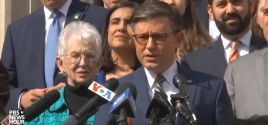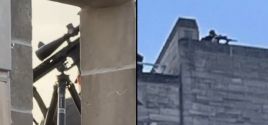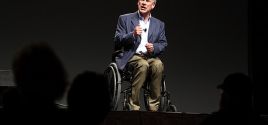Chicago, Los Angeles Police Departments Have Been Using 'Stingrays On Steroids' For Over A Decadeby Tim CushingTechdirt Aug. 18, 2015 |
Popular 
Mike Johnson Pushes Debunked Lie That Israeli Babies Were 'Cooked in Ovens' On October 7

'Sniper Seen on Roof Overlooking Pro-Palestine Protest' at Indiana University

'It Has to Be Stopped': Netanyahu Demands Pro-Palestine Protests at U.S. Colleges Be Shut Down

'These Protesters Belong in Jail': Gov. Abbott Cheers Arrest of Pro-Palestine Protesters at UT Austin

Claim Jewish Student Was 'Stabbed In The Eye' by Pro-Palestine Protester Draws Mockery After Video Released
 More evidence has surfaced showing local law enforcement agencies are using high-powered surveillance equipment -- equipment originally designed for the military and highly-recommended by the NSA. Ali Winston and the Center for Investigative Reporting have obtained documents showing both Chicago and Los Angeles have used "dirt boxes" (DRT -- Digital Receiver Technology "boxes:" high-powered cell site simulators) since 2005. In Chicago, the Digital Receiver Technology equipment was purchased in 2005 with funds collected in asset forfeiture cases. In Los Angeles, the police department purchased a package of Digital Receiver Technology equipment with $260,000 in homeland security grant funding. The sole-source purchase was approved unanimously by the Los Angeles City Council in 2005. Both departments also use StingRays, a more commonly known cell-site simulator manufactured by the Florida-based Harris Corp.As usual, the agencies remain close-lipped about their DRTbox deployment. In fact, the LAPD simply refused to release responsive documents about its DRT equipment, in violation of the state's FOI laws. Boeing, which purchased DRT in 2008, has also refused to comment. The LAPD's refusal to hand over documents didn't stop the Center for Investigative Reporting from uncovering its DRTbox purchase, however. It found confirmation of the department's DHS grant-supported purchase in the city's public records. While much of what's been uncovered about Stingrays and other cell tower spoofers tends to focus on the collection of phone and location data, the devices are also used to intercept communications. Documents from Digital Receiver Technology clearly spell out these interception capabilities. The DRT1000 System Software is a suite of applications that includes the software that runs on the DRT system, Alaska (GUI), Applause (Audio Playback), DF and Geolocation (with DRTview), and Yukon (IP Configuration utility). The DRT1000 system may be used to: identify and collect audio, data and Signal Related Information (SRI).The company also manufactures auxiliary products that capture "push-to-talk" communications, something that has been used in the past to elude law enforcement surveillance efforts. While very few law enforcement agencies have produced documents indicating the purchase and use of these "Stingrays on steroids," DRT's own marketing materials proudly note the company has sold more than 5,000 units as of May 2015. And it is indeed bulked-up. The Los Angeles city clerk's notes on the LAPD's purchase states that DRT's products offer more capabilities than its competitors. The LAPD has done extensive research to determine the best product available for tracking cellular telephone calls. Most vendors only offered a product that could track phones issued by one or two cellular service providers. Conversely, DRT's equipment can track and monitor all cellular phone traffic, making it the most advanced product on the market. To match the capability of DRT's product, the LAPD would be required to purchase several individual systems from other vendors at a far greater total cost.This increased capability comes at a premium price, but it's not as though local police departments will be expected to pick up the tab. Funding from the FY04 State Homeland Security Grant Program (Council File 04-2499), in the amount of $260,000, was previously allocated for the purchase of a Cell Phone Tracking System (CPTS).Chicago's route to greater surveillance capabilities ran through its asset forfeiture program. In addition to its DRT purchases, the 193 pages of responsive documents show multiple purchases from Harris, including multiple upgrades to existing equipment. As is the case nearly everywhere, the acquisitions were done in secret and usually without a true bidding process -- a very popular option for departments acquiring surveillance technology. No bidding process means no generation of additional FOIA-able paperwork. Not found among the responsive documents was anything detailing policies regarding use of these powerful devices or any examination of potential privacy implications by the agencies seeking the equipment. Despite almost-daily revelations of cell tower spoofer acquisition and use (via FOIA requests, mostly), law enforcement agencies are still willing to drop cases and dismiss evidence rather than allow additional public scrutiny. The use of these tools also continues to be hidden behind pen register requests and parallel construction. The good news is that the continued revelations have finally caught the eye of the nation's legislators. U.S. Rep. Alan Grayson, D-Florida, who is on the House Foreign Affairs and Science, Space and Technology committees, said the use of technology with eavesdropping capabilities without a warrant is “a clear violation of the Fourth Amendment.”Whether or not this additional attention will result in Fourth Amendment-friendly legislation remains to be seen. Strongly-worded statements are great, but it will take a real, concerted effort to create a warrant requirement, much less restore some expectation of privacy to "business records" like connection and location info. Digital Receiver Technology Presentation (PDF) Int Spec Sheet drt1000 Software Rev 3 3 Int 2 (PDF) 15 3508 Responsive Documents (PDF) |



